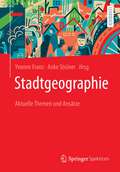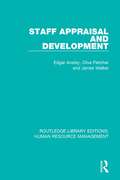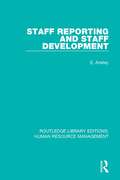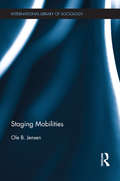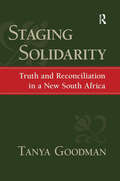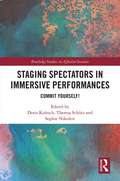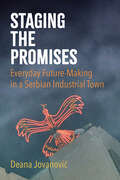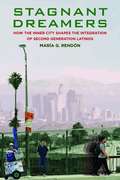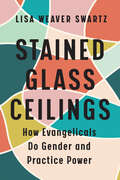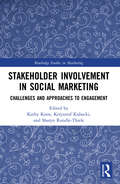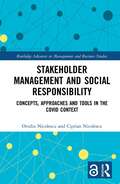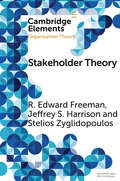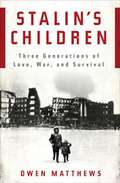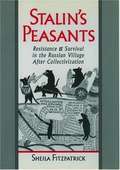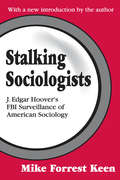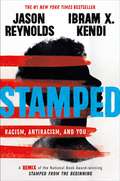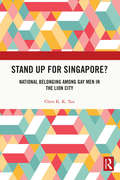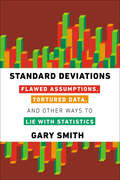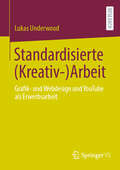- Table View
- List View
Stadtgeographie: Aktuelle Themen und Ansätze
by Anke Strüver Yvonne FranzStädte sind Gamechanger globaler wie lokaler Veränderungsprozesse geworden. Ob Klimakrise, Mobilitäts- und Energiewende, Digitalisierung oder demographischer Wandel – Städte sind nicht nur Orte, an denen diese Themen stattfinden, sie versprechen oftmals auch die notwendigen Hebelwirkungen, um Wandel, Wende und Transformation zu verorten und umzusetzen. Das im Jahr 2007 eingeläutete „urbane Zeitalter“ benennt einen zentralen globalen Wendepunkt: Weltweit leben mehr Einwohner*innen in Städten als in ländlich-peripheren Räumen.Dieser Band zeigt die Stadt als Ermöglichungsraum für gesellschaftliche Veränderung auf. Das Lehrbuch ist explizit mit interdisziplinärer Betrachtungsweise raumrelevanter Gesellschaftsprozesse konzipiert. Es erweitert die Stadtgeographie und versteht sich als Plädoyer für ein gleichermaßen komplexes wie relationales und prozessuales Denken in der stadtgeographischen Lehre und Forschung.Folgende aktuelle Themen und Ansätze der Stadtgeographie werden anhand vielschichtiger und kritischer Fragen behandelt:Welche gesellschaftlichen Alltagspraktiken prägen aktuell städtisches Zusammenleben, welche werden dominant, welche bleiben unsichtbar?Wie und wodurch findet Aneignung im urbanen Raum statt – und wer ist davon ausgeschlossen?Wie gelingt Teilhabe in der Stadt und welche Rolle spielen Infrastrukturen wie Wohnraum, Frei- und Grünräume, Verkehr und Digitalisierung?Dieses Lehrbuch unterstützt Studierende der Geographie und der sozialwissenschaftlichen Nachbardisziplinen auf Einsteiger*innen- als auch Fortgeschrittenenniveau in der Auseinandersetzung mit stadtrelevanten Themen.
Staff Appraisal and Development (Routledge Library Editions: Human Resource Management)
by Clive Fletcher James Walker Edgar AnsteyOrganisations of all kinds have invested a great deal of time and effort in staff appraisal and management development, continually re-defining their aims and methods. This book, first published in 1976, reviews the progress made by 17 organisations in both public and private sectors. It presents the findings of an extensive series of research studies that assess the effectiveness of appraisal interviews and identify the factors contributing to their success or failure. Looking beyond appraisal, further measures needed to increase job satisfaction and efficiency are outlined. These include more systematic career development plans for all staff and fresh initiatives to secure their more active participation in the appraisal process. This title will be of interest to those who are concerned in management, and those studying business studies and human resource management.
Staff Reporting and Staff Development (Routledge Library Editions: Human Resource Management)
by E. AnsteyThis book, first published in 1961, considers the schemes based on various combinations of written reports and interviews in staff appraisal and development. It also discusses the mutual responsibilities of staff and management, and the objectives of staff assessment. This title will be of interest to students of business studies and human resource management.
Staging Dissent: Young Women of Color and Transnational Activism
by Lisa WeemsStaging Dissent: Young Women of Color and Transnational Activism seeks to interrupt normative histories of girlhood dominated by North American contexts and Western feminisms to offer an alternative history of girlhoods produced by and through globalization. Weems does this by offering three case studies that exemplify how transnational and indigenous youth dissent against capitalism and colonialism through situated "guerilla pedagogies."
Staging Mobilities (International Library of Sociology)
by Ole B. JensenIn recent years, the social sciences have taken a ‘mobilities turn’. There has been a developing realisation that mobilities do not ‘just happen’. Mobilities are carefully and meticulously designed, planned and staged (from above). However, they are equally importantly acted out, performed and lived as people are ‘staging themselves’ (from below). Staging mobilities is a dynamic process between ‘being staged’ (for example, being stopped at traffic lights) and the ‘mobile staging’ of interacting individuals (negotiating a passage on the pavement). Staging Mobilities is about the fact that mobility is more than movement between point A and B. It explores how the movement of people, goods, information, and signs influences human understandings of self, other and the built environment. Moving towards a new understanding of the relationship between movement, interaction and environments, the book asks: what are the physical, social, technical, and cultural conditions to the staging of contemporary urban mobilities? Jensen argues that we need to understand the contemporary city as an assemblage of circulating people, goods, information and signs in relational networks creating the ‘meaning of movement’. The book will be of interest to students and scholars of sociology, urban studies, mobility studies, architecture and cultural studies.
Staging Queer Feminisms: Sexuality And Gender In Australian Performance, 2005-2015 (Contemporary Performance Interactions )
by Sarah FrenchThis book examines sexuality, gender and race in Australia's vibrant independent theatre and performance culture. It analyses selected feminist and queer performances that interrogate the cultural construction of sexuality and gender, challenge the normative trends of mainstream Australian society and culture and open up spaces for alternative representations of gender identity and sexual expression. Offering the first full-length study on sexuality and gender in Australian theatre since 2005, this book reveals a resurgence of feminist themes in independent performance and explores the intersection of feminist and queer politics. Ranging across drag, burlesque, cabaret, theatre and performance art, the book provides an accessible and engaging account of some of the most innovative, entertaining and politically subversive Australian theatrical works from the past decade.
Staging Solidarity: Truth and Reconciliation in a New South Africa
by Jeffrey C. Alexander Tanya Goodman Ronald EyermanThe South African Truth and Reconciliation Commission (TRC) is a modern social drama that enabled the nation's apartheid past to be constructed as a cultural trauma, and by doing so created a new collective narrative of diversity and inclusion. The TRC relied primarily on testimonies from victims and perpetrators of apartheid violence who came forward to tell their stories in a public forum. Rather than simply serving as data for setting the historical record straight, this book shows that it was not only the content of these testimonies but also how these stories were told and what values were attached to them that became significant. Goodman argues that the performative nature of the TRC process effectively designated the past as profane and simultaneously imagined a sacred future community based on democratic idealism and universal solidarity.
Staging Spectators in Immersive Performances: Commit Yourself! (Routledge Studies in Affective Societies)
by Doris Kolesch Theresa Schütz Sophie NikoleitAt present, we are witnessing a significant transformation of established forms of spectatorship in theatre, performance art and beyond. In particular, immersive and participatory forms of theatre allow audiences and performers to interact in a shared performance space. Staging Spectators in Immersive Performances discusses forms and concepts of contemporary spectatorship and explores various modes of audience participation in theory as well as in practice. The volume also reflects on what new terms and methods must be developed in order to address the theoretical challenges of contemporary immersive performances. Split into three parts, Staging Spectators in Immersive Performances, respectively, focuses on various strategies for mobilising the audience, methodological questions for research on being a spectator in immersive and participatory forms of theatre, and thematising new modes of partaking and ways of spectating in contemporary art. Poignantly capturing experiences that can be viewed as manifestations of affective relationality in the strongest possible sense, this volume will appeal to students and researchers interested in fields such as Theatre and Performance Studies, Media Studies and Philosophy.
Staging the New Berlin: Place Marketing and the Politics of Urban Reinvention Post-1989 (Planning, History and Environment Series)
by Claire ColombThis book explores the politics of place marketing and the process of ‘urban reinvention’ in Berlin between 1989 and 2011. In the context of the dramatic socio-economic restructuring processes, changes in urban governance and physical transformation of the city following the Fall of the Wall, the ‘new’ Berlin was not only being built physically, but staged for visitors and Berliners and marketed to the world through events and image campaigns which featured the iconic architecture of large-scale urban redevelopment sites. Public-private partnerships were set up specifically to market the ‘new Berlin’ to potential investors, tourists, Germans and the Berliners themselves. The book analyzes the images of the city and the narrative of urban change, which were produced over two decades. In the 1990s three key sites were turned into icons of the ‘new Berlin’: the new Postdamer Platz, the new government quarter, and the redeveloped historical core of the Friedrichstadt. Eventually, the entire inner city was ‘staged’ through a series of events which turned construction sites into tourist attractions. New sites and spaces gradually became part of the 2000s place marketing imagery and narrative, as urban leaders sought to promote the ‘creative city’. By combining urban political economy and cultural approaches from the disciplines of urban politics, geography, sociology and planning, the book contributes to a better understanding of the interplay between the symbolic ‘politics of representation’ through place marketing and the politics of urban development and place making in contemporary urban governance.
Staging the Promises: Everyday Future-Making in a Serbian Industrial Town
by Deana JovanovićStaging the Promises reveals how inhabitants of Bor, a Serbian copper-processing and mining town that lived through prosperous Yugoslav times and a post-socialist decline, were the audience theatrically performed promises of aspirational futures. Deana Jovanović chronicles the efforts of the copper-processing company and the town's authorities to theatrically perform promises of better economic, urban, environmental, infrastructural and post-industrial futures. Her book asks: What impact did the staging of promises have on the residents? What temporal, material, and political effects did these performances generate? How did they shape the citizens' futures and their present?Jovanović offers many ethnographic examples of ambivalence in people's orientation to their futures, while residents balanced hope with despair, disillusionment, and dismay. Staging the Promises highlights how the performances shaped the present, and how, in a Gramscian twist, they sustained hope alongside power dynamics that residents often criticized.Staging the Promises assesses the performative ways through which contemporary capitalist futures are remade. For Jovanović, Bor represents a site that reflects a current global trend: staging the promises of enhanced futures today play a significant role in contemporary populist politics. Through them, she argues, distant futures become gradually withdrawn from people's horizons.
Stagnant Dreamers: How the Inner City Shapes the Integration of the Second Generation
by Maria G. RendonA quarter of young adults in the U.S. today are the children of immigrants, and Latinos are the largest minority group. In Stagnant Dreamers, sociologist and social policy expert María Rendón follows 42 young men from two high-poverty Los Angeles neighborhoods as they transition into adulthood. Based on in-depth interviews and ethnographic observations with them and their immigrant parents, Stagnant Dreamers describes the challenges they face coming of age in the inner city and accessing higher education and good jobs, and demonstrates how family-based social ties and community institutions can serve as buffers against neighborhood violence, chronic poverty, incarceration, and other negative outcomes. Neighborhoods in East and South Central Los Angeles were sites of acute gang violence that peaked in the 1990s, shattering any romantic notions of American life held by the immigrant parents. Yet, Rendón finds that their children are generally optimistic about their life chances and determined to make good on their parents’ sacrifices. Most are strongly oriented towards work. But despite high rates of employment, most earn modest wages and rely on kinship networks for labor market connections. Those who made social connections outside of their family and neighborhood contexts, more often found higher quality jobs. However, a middle-class lifestyle remains elusive for most, even for college graduates. Rendón debunks fears of downward assimilation among second-generation Latinos, noting that most of her subjects were employed and many had gone on to college. She questions the ability of institutions of higher education to fully integrate low-income students of color. She shares the story of one Ivy League college graduate who finds himself working in the same low-wage jobs as his parents and peers who did not attend college. Ironically, students who leave their neighborhoods to pursue higher education are often the most exposed to racism, discrimination, and classism. Rendón demonstrates the importance of social supports in helping second-generation immigrant youth succeed. To further the integration of second-generation Latinos, she suggests investing in community organizations, combating criminalization of Latino youth, and fully integrating them into higher education institutions. Stagnant Dreamers presents a realistic yet hopeful account of how the Latino second generation is attempting to realize its vision of the American dream.
Stained Glass Ceilings: How Evangelicals Do Gender and Practice Power
by Lisa Weaver SwartzStained Glass Ceilings speaks to the intersection of gender and power within American evangelicalism by examining the formation of evangelical leaders in two seminary communities.Southern Baptist Theological Seminary inspires a vision of human flourishing through gender differentiation and male headship. Men practice “Godly Manhood," and are taught to act as the "head" of a family, while their wives are socialized into codes of “Godly Womanhood" that prioritize prescribed gender roles. This power structure privileges men yet offers agency to their wives in women-centered spaces and through marital relationships. Meanwhile, Asbury Theological Seminary promises freedom from gendered hierarchies. Appealing to a story of gender-blind equality, Asbury welcomes women into classrooms, administrative offices, and pulpits. But the institution’s construction of egalitarianism obscures the fact that women are rewarded for adapting to an existing male-centered status quo rather than for developing their own voices as women. Featuring high-profile evangelicals such as Al Mohler and Owen Strachan, along with young seminarians poised to lead the movement in the coming decades, Stained Glass Ceilings illustrates the liabilities of white evangelical toolkits and argues that evangelical culture upholds male-centered structures of power even as it facilitates meaning and identity.
Stakeholder Analysis and Sport Organisations (Routledge Research in Sport Business and Management)
by Barrie Houlihan Anna-Maria Strittmatter Josef FahlénThis book provides a critical examination of the origins and development of stakeholder theory within sport management research and expands the existing literature by providing insights on stakeholding in sport from various perspectives, such as governance, communication, and marketing. Examining cases from around the world and from a wide range of different sporting contexts, each chapter reflects on key insights derived from stakeholder theory before offering an analysis of the limitations of the theory and the ways in which it might be fruitfully extended or developed. It offers suggestions on how the literature on stakeholding in sport can be advanced in order to provide knowledge relevant not only to sport studies, but also to organization theory more broadly, and points to future avenues of inquiry in order to extend the reach of stakeholder theory and other inter-organizational perspectives in sport management research. Stakeholder Analysis and Sport Organisations is fascinating reading for any advanced student, researcher, policy maker or practitioner with an interest in sport management, sport governance, sport development or organisational theory.
Stakeholder Involvement in Social Marketing: Challenges and Approaches to Engagement (Routledge Studies in Marketing)
by Kathy KnoxThis book is the first to provide evidence-based experience to showcase how stakeholder management can be applied within social marketing programs, as well providing contemporary discussions of social marketing research. The book aims to bring practitioners and academics together to address the calls made by scholars to address inherent challenges involved in identifying, involving and prioritising different stakeholders in social marketing interventions. Through sharing real-world experience, the text aims to extend and synthesise current knowledge in the field and contribute to establishing stronger and long-lasting alliances with stakeholders involved in social marketing interventions with an aim of ensuring sustainable behavioural change. This book features a diverse series of case studies from different countries (including but not limited to Australia, Finland, India, Slovenia, the United Kingdom) conducted in various behaviour change contexts (including alcohol consumption, nutrition intake, and breast feeding). Leading international social marketing and social science scholars provide case studies on stakeholder involvement in an intervention or multiple interventions and elucidate relevant lessons to inform theoretical as well as practical implications for multi-stakeholder social marketing interventions. This volume will be of interest to researchers, advanced students, practitioners and policy makers in social marketing and health policy.
Stakeholder Management and Social Responsibility: Concepts, Approaches and Tools in the Covid Context (Routledge Advances in Management and Business Studies)
by Ovidiu Nicolescu Ciprian NicolescuThe main objective of this book is to provide an innovative set of concepts and tools regarding company management, internal and external stakeholders and social responsibilities, reflecting the necessities and opportunities generated by the digital transformation, the transition to a knowledge-based economy, and the COVID-19 crisis. The book, based on a holistic vision and contextual approach of business, contributes to the development of company management and stakeholder and social responsibility theories and practices, being structured in 12 chapters. The original company management vision, approaches, and tools are based on three pillars: a new "manager–relevant stakeholder" rather than "manager–subordinate" managerial paradigm; a new type of company social responsibility rather than corporate social responsibility; and a new concept of company-relevant stakeholder rather than that of salient stakeholders. The book contains two innovative managerial mechanisms: the managerial synapse and company-relevant stakeholders-based management system able to help companies and stakeholders face successfully the challenges of digital transformation and the COVID-19 crisis and to generate greater organization functionality and performance. The book will be of interest to company managers and management specialists, management academics, consultants and researchers, and MBA students interested in a style of management with social responsibility at the forefront.
Stakeholder Theory: Concepts and Strategies (Elements in Organization Theory)
by R. Edward Freeman Jeffery S. Harrison Stelios ZyglidopoulosThe stakeholder perspective is an alternative way of understanding how companies and people create value and trade with each other. Freeman, Harrison and Zyglidopoulos discuss the foundation concepts and implementation of stakeholder management as well as the advantages this approach provides to firms and their managers. They present a number of tools that managers can use to implement stakeholder thinking, better understand stakeholders and create value with and for them. The Element concludes by discussing how managers can create stakeholder oriented control systems and by examining some of the important stakeholder-related issues that are worthy of future scholarly and managerial attention.
Stalin's Children: Three Generations of Love, War, and Survival
by Owen MatthewsA transcendent history/memoir of one family's always passionate, sometimes tragic connection to Russia. On a midsummer day in 1937, a black car pulled up to a house in Chernigov, in the heart of the Ukraine. Boris Bibikov--Owen Matthews's grandfather--kissed his wife and two young daughters good-bye and disappeared inside the car. His family never saw him again. His wife would soon vanish as well, leaving Lyudmila and Lenina alone to drift across the vast Russian landscape during World War II. Separated as the Germans advanced in 1941, they were miraculously reunited against all odds at the war's end. Some twenty-five years later, in the early 1960s, Mervyn Matthews--Owen's father--followed a lifelong passion for Russia and moved to Moscow to work for the British embassy. He fell in and out with the KGB, and despite having fallen in love with Lyudmila, he was summarily deported. For the next six years, Mervyn worked day and night to get Lyudmila out of Russia, and when he finally succeeded, they married. Decades on from these events, Owen Matthews--then a young journalist himself in Russia--came upon his grandfather's KGB file recording his "progress from life to death at the hands of Stalin's secret police." Stimulated by its revelations, he has pieced together the tangled and dramatic threads of his family's past and present, making sense of the magnetic pull that has drawn him back to his mother's homeland. Stalin's Children is an indelible portrait of Russia over seven decades and an unforgettable memoir about how we struggle to define ourselves in opposition to our ancestry only to find ourselves aligning with it. "I came to Russia to get away from my parents," writes Matthews. "Instead I found them there, though for a long time I didn't know it or refused to see it. This is a story about Russia and my family, about a place which made us and freed us and inspired us and very nearly broke us. And it's ultimately a story about escape, about how we all escaped from Russia, even though all of us--even my father, a Welshman, who has no Russian blood, even me, who grew up in England--still carry something of Russia inside ourselves, infecting our blood like a fever."
Stalin's Peasants: Resistance and Survival in the Russian Village after Collectivization
by Sheila FitzpatrickDrawing on newly-opened Soviet archives, especially the letters of complaint and petition with which peasants deluged the Soviet authorities in the 1930s, Stalin's Peasants analyzes peasants' strategies of resistance and survival in the new world of the collectivized village. Stalin's Peasants is a story of struggle between transformationally-minded Communists and traditionally-minded peasants over the terms of collectivization- a struggle of opposing practices, not a struggle in which either side clearly articulated its position. But it is also a story about the impact of collectivization on the internal social relations and culture of the village, exploring questions of authority and leadership, feuds, denunciations, rumors, and changes in religious observance. For the first time, it is possible to see the real people behind the facade of the "Potemkinvillage" created by Soviet propagandists. In the Potemkin village, happy peasants clustered around a kolkhoz (collective farm) tractor, praising Stalin and promising to produce more grain as a patriotic duty. In the real Russian village of the 1930s, as we learn from Soviet political police reports,sullen and hungry peasants described collectivization as a "second serfdom," cursed all Communists, and blamed Stalin personally for their plight. Sheila Fitzpatrick's work is truly a landmark in studies of the Stalinist period- a richly-documented social history told from the traumatic experiences of the long-suffering underclass of peasants. Anyone interested in Soviet and Russian history, peasant studies, or social history will appreciate this major contribution to our understanding of life in Stalin's Russia.
Stalinism, Maoism, and Socialism in Higher Education (Global Histories of Education)
by Lee S. ZhuThis book is a comparative study of the endeavors to create a socialist system of higher education in the Soviet Union under Stalin and in China under Mao. It is organized around three themes: the convergence of Maoism with Stalinism in the early 1950s, which induced the transnational transplantation of the Soviet model of higher education to China; historical convergence between Stalinism of the First Five-Year Plan period (1928–1932) and Maoism of the Great Leap period (1958–1960), which was prominently manifested in Soviet and Chinese higher education policies in these respective periods; the eventual divergence of Maoism from Stalinism on the definition of socialist society, which was evinced in the different final outcomes of the Maoist and Stalinist endeavors to create a socialist system of higher learning.
Stalking Sociologists: J. Edgar Hoover's FBI Surveillance of American Sociology
by Renee C. FoxUntil recent years, the Federal Bureau of Investigation enjoyed an exalted reputation as America's premier crime-fighting organization. However, it is now common knowledge that the FBI and its long-time director, J. Edgar Hoover, were responsible for the creation of a massive internal security apparatus that undermined the very principles of freedom and democracy they were sworn to protect. While no one was above suspicion, Hoover appears to have held a special disdain for sociologists and placed many of the profession's most prominent figures under surveillance. In Stalking Sociologists, Mike Forrest Keen offers a detailed account of the FBI's investigations within the context of an overview of the history of American sociology.This ground-breaking analysis history uses documents obtained through the Freedom of Information Act. Keen argues that Hoover and the FBI marginalized sociologists such as W. E. B. Du Bois and C. Wright Mills, tried to suppress the development of a Marxist tradition in American sociology, and likely pushed the mainstream of the discipline away from a critique of American society and towards a more quantitative and scientific direction. He documents thousands of man-hours and millions of dollars dedicated to this project. Faculty members of various departments of sociology were recruited to inform on the activities of their colleagues and the American Sociological Association was a target of FBI surveillance. Keen turns sociology back upon the FBI, using the writings and ideas of the very sociologists Hoover investigated to examine and explain the excesses of the Bureau and its boss. The result is a significant contribution to the collective memory of American society as well as the accurate history of the sociological discipline."This ground-breaking book documents in meticulous detail decades of harassment and surveillance of major American sociologists by the FBI. The misuse of power...will outrage all Americans a
Stamped: A Remix of the National Book Award-winning Stamped from the Beginning
by Jason Reynolds Ibram X. KendiThe crucial, empowering, #1 New York Times bestselling exploration of racism—and antiracism—in America.This is NOT a history book.This is a book about the here and now. A book to help us better understand why we are where we are.A book about race. The construct of race has always been used to gain and keep power, to create dynamics that separate and silence. This remarkable reimagining of Dr. Ibram X. Kendi's National Book Award-winning Stamped from the Beginning reveals the history of racist ideas in America and inspires hope for an antiracist future. It takes you on a race journey from then to now, shows you why we feel how we feel, and why the poison of racism lingers. It also proves that while racist ideas have always been easy to fabricate and distribute, they can also be discredited. Through a gripping, fast-paced, and energizing narrative written by beloved award-winner Jason Reynolds, this book shines a light on the many insidious forms of racist ideas--and on ways readers can identify and stamp out racist thoughts in their daily lives. Download the free educator guide here: https://www.hachettebookgroup.com/wp-content/uploads/2020/03/Stamped-Educator-Guide.pdfNow available for younger readers: Stamped (for Kids): Racism, Antiracism, and You
Stand Up for Singapore?: National Belonging among Gay Men in the Lion City
by Chris K. TanThis book details queer Singaporeans’ efforts to fashion their sense of national belonging and highlights how the Singaporean state could have better incorporated its diverse population into its nation-building framework. Inspired by previous studies that document the history of the gay rights movement, the construction of post-colonial lesbian identities, and online queer activism, this book invokes the concept of "cultural citizenship." It argues that as citizens, gay men appreciate the material wealth the People’s Action Party (PAP) has created. Yet, the PAP’s illiberal governance inhibits the development of genuine fondness for the party and, by extension, the nation. Worse, the state’s heteronormative social policies further alienate these men. Even so, queer Singaporeans continue to assert their national belonging during Pink Dot and other queer events. As the first monograph to focus on Singaporean gay men, this book aims to enrich scholarly understanding of queer life in Southeast Asia. Academics and students of anthropology and sociology (especially those interested in the nation-state), Southeast Asian Studies, and Queer Studies will find this book innovative and insightful.
Stand by Me: The Risks and Rewards of Mentoring Today's Youth (The Family and Public Policy #2)
by Jean E. RhodesA child at loose ends needs help, and someone steps in--a Big Brother, a Big Sister, a mentor from the growing ranks of volunteers offering their time and guidance to more than two million American adolescents. Does it help? How effective are mentoring programs, and how do they work? Are there pitfalls, and if so, what are they? Such questions, ever more pressing as youth mentoring initiatives expand their reach at a breakneck pace, have occupied Jean Rhodes for more than a decade. In this provocative, thoroughly researched, and lucidly written book, Rhodes offers readers the benefit of the latest findings in this burgeoning field, including those from her own extensive, groundbreaking studies. Outlining a model of youth mentoring that will prove invaluable to the many administrators, caseworkers, volunteers, and researchers who seek reliable information and practical guidance, Stand by Me describes the extraordinary potential that exists in such relationships, and discloses the ways in which nonparent adults are uniquely positioned to encourage adolescent development. Yet the book also exposes a rarely acknowledged risk: unsuccessful mentoring relationships--always a danger when, in a rush to form matches, mentors are dispatched with more enthusiasm than understanding and preparation--can actually harm at-risk youth. Vulnerable children, Rhodes demonstrates, are better left alone than paired with mentors who cannot hold up their end of the relationships. Drawing on work in the fields of psychology and personal relations, Rhodes provides concrete suggestions for improving mentoring programs and creating effective, enduring mentoring relationships with youth.
Standard Deviations: Flawed Assumptions, Tortured Data, and Other Ways to Lie with Statistics
by Gary SmithHow statistical data is used, misused, and abused every day to fool us: “A very entertaining book about a very serious problem.” —Robert J. Shiller, winner of the Nobel Prize in Economics and author of Irrational ExuberanceDid you know that baseball players whose names begin with “D” are more likely to die young? That Asian Americans are most susceptible to heart attacks on the fourth day of the month? That drinking a full pot of coffee every morning adds years to your life, but one cup a day increases your pancreatic cancer risk? These “facts” have been argued with a straight face by credentialed researchers and backed up with reams of data and convincing statistics. As Nobel Prize–winning economist Ronald Coase cynically observed, “If you torture data long enough, it will confess.” Lying with statistics is a time-honored con. In Standard Deviations, economics professor Gary Smith walks us through the various tricks and traps that people use to back up their own crackpot theories. Sometimes, the unscrupulous deliberately try to mislead us. Other times, the well-intentioned are blissfully unaware of the mischief they are committing. Today, data is so plentiful that researchers spend precious little time distinguishing between good, meaningful indicators and total rubbish. Not only do others use data to fool us, we fool ourselves. Drawing on breakthrough research in behavioral economics and using clear examples, Standard Deviations demystifies the science behind statistics and makes it easy to spot the fraud all around us.“An entertaining primer . . . packed with figures, tables, graphs and ludicrous examples from people who know better (academics, scientists) and those who don’t (political candidates, advertisers).” —Kirkus Reviews (starred review)
Standardisierte (Kreativ-)Arbeit: Grafik- und Webdesign und YouTube als Erwerbsarbeit
by Lukas UnderwoodFolgt man den Diagnosen verschiedener Soziolog:innen, dann ist kreativ zu sein keine Anforderung mehr an nur einige wenige Arbeitnehmer:innen, sondern bildet das zentrale Dispositiv der modernen kapitalistischen Gesellschaft. Kreativ zu arbeiten setzt den gängigen Annahmen nach voraus, erstens kontinuierlich Neues hervorzubringen und zweitens einer nicht standardisierten Tätigkeit nachzugehen und nicht standardisierte Produkte hervorzubringen. Prädestiniert für solche Tätigkeiten scheinen Solo-Selbstständige aus der Kultur- und Kreativwirtschaft zu sein. Die vorliegende Arbeit geht der Frage nach, welche Rolle Kreativität für die Arbeit von ebendiesen spielt. Hierzu wird das Verhältnis von Kreativität und Standardisierung einer genaueren Betrachtung unterzogen, wobei der Fokus auf der Ebene des Arbeitsprozesses, des Produkts sowie der Handlung liegt. Empirische Grundlage bilden 18 qualitative Interviews mit Solo-Selbstständigen aus den Bereichen Grafik- und Webdesign sowie YouTube. Die Analyse rückt die Perspektive der Befragten in den Mittelpunkt und arbeitet zunächst die jeweiligen Besonderheiten der Arbeit in den beiden genannten Bereichen heraus. Die Ergebnisse der empirischen Analyse werden zur Reflexion über die drei genannten Ebenen genutzt und das Verhältnis von Standardisierung und Kreativität als dialektisch bestimmt. Diese Dialektik zeigt sich gegenstandsbezogen und ist zutiefst verwurzelt in den spezifischen Bedingungen, unter denen die Arbeit ausgeführt wird.
